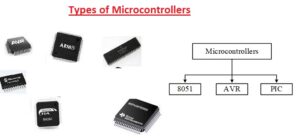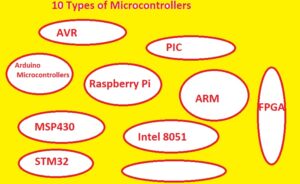 The brains of the electrical devices we use every day are microcontrollers. They are in charge of managing how gadgets like cell phones, appliances, cars, and other things operate. It might be daunting for a newcomer to select the ideal microcontroller for their project. There are different types o microcontrollers that come with different features and functions Here we have discussed the top 10 types of microcontrollers
The brains of the electrical devices we use every day are microcontrollers. They are in charge of managing how gadgets like cell phones, appliances, cars, and other things operate. It might be daunting for a newcomer to select the ideal microcontroller for their project. There are different types o microcontrollers that come with different features and functions Here we have discussed the top 10 types of microcontrollers
Table of Contents
- Introduction to Microcontrollers
- Types of Microcontrollers
-
- Arduino Microcontrollers
- Raspberry Pi Microcontrollers
- AVR Microcontrollers
- PIC Microcontrollers
- ARM Microcontrollers
- MSP430 Microcontrollers
- Intel 8051 Microcontrollers
- STM32 Microcontrollers
- NXP LPC Microcontrollers
- FPGA Microcontrollers
-
- Comparison of Microcontrollers
- Factors to Consider When Choosing a Microcontroller
- Benefits of Using Microcontrollers
- Applications of Microcontrollers
- Future of Microcontrollers
- Conclusion
- FAQs
Introduction to Microcontrollers
A microcontroller is a tiny computer on an individual integrated circuit that is made to manage a particular function. It is created with the use of one chip that consists of CPU memory unit and input and output devices. Applications for microcontrollers are numerous and include industrial automation, medical equipment, household appliances, and more.
10 Types of Microcontrollers
Microcontrollers have different types each comes with different features and functionalities. The top 10 categories of microcontrollers are as follows:

1. Arduino Microcontrollers
It is open-source Arduino hardware and software platform that is popular for developing interactive projects. It is a microcontroller that is the finest option for beginners and is easy to program using the Arduino Integrated Development Environment. Robotics to home automation are just a few of the applications that Arduino microcontrollers can be applied
2. Raspberry Pi Microcontrollers
The Raspberry Pi is a small-size board, an inexpensive module that is frequently used in different projects. It comes with different types of input/output pins that may be used to control external devices, it is a main part of building DIY projects. Python and Scratch are commonly used programming languages that can be used to program Raspberry Pi microcontrollers.
3. AVR Microcontrollers
The Atmel Company designed the AVR microcontroller family of microcontrollers. They are extensively used in duiffiet fields of engineering like consumer electronics, industrial automation, and also part of the automobile industry. These boards are preferred for their high performance and low power requirements.
4. PIC Microcontrollers
PIC microcontrollers are a group of microcontrollers created by Microchip Technology. These boards are part of different applications such as automotive, aerospace, and medical devices. PIC microcontrollers are preferred for their features like low power consumption, high-performance capabilities, and easy to use feature
5. ARM Microcontrollers
A series of microcontrollers known as ARM microcontrollers were created by ARM Holdings. It is part of different engineering fields in consumer electronics, industrial automation, and the automobile industry. High performance, low power consumption, and scalability are all hallmarks of ARM microcontrollers.
6. MSP430 Microcontrollers
Texas Instruments created the MSP430 microcontroller series of devices. They are widely used in different projects such as wireless sensing, smart grid, and portable medical equipment. Microcontrollers using the MSP430 architecture are famous for their goo performance and extremely low power consumption.
7. Intel 8051 Microcontrollers
The first members of the Intel 8051 family of microcontrollers were commonly available in 1980. They are common parts of different modules like automobiles, medical equipment, and home appliances. It is well known that Intel 8051 microcontrollers are inexpensive and simple to use.
8. STM32 Microcontrollers
The STM32 series of microcontrollers was manufactured by STMicroelectronics. They are mostly used in different applications, like consumer electronics, automotive, and industrial automation. The low power consumption, great performance, and support for a variety of communication protocols of STM32 microcontrollers are well recognized..
9. NXP LPC Microcontrollers
The NXP LPC series of microcontrollers was created by NXP Semiconductors. They are extensively utilized in a wide range of applications, including as automotive, medical, and home automation. The great performance and low power consumption of NXP LPC microcontrollers are well recognized.
10. FPGA Microcontrollers
Field-programmable gate array (FPGA) microcontrollers are microcontrollers that utilize FPGAs as their main processing units. They are quite configurable and may be set up to carry out a variety of activities. FPGA microcontrollers are frequently employed in fields like aerospace and military that call for high-performance computing.
Comparison of Microcontrollers
Picking the appropriate microcontroller for your project is crucial since each kind has a unique set of features and capabilities. The top 10 categories of microcontrollers are contrasted as follows:
| Microcontroller Type | Features | Applications |
|---|---|---|
| Arduino | Open-source, easy to program, versatile | Robotics, home automation |
| Raspberry Pi | Low-cost, credit card-sized computer, easy to use | Education, DIY projects |
| AVR | Low power consumption, high-performance capabilities | Automotive, industrial automation, consumer electronics |
| PIC | Low power consumption, high-performance capabilities, ease of use | Automotive, aerospace, medical devices |
| ARM | Low power consumption, high-performance capabilities, scalability | Automotive, industrial automation, consumer electronics |
| MSP430 | Ultra-low power consumption, high-performance capabilities | Smart grid, wireless sensing, portable medical devices |
| Intel 8051 | Low cost, ease of use | Home appliances, automotive, medical devices |
| STM32 | Low power consumption, high-performance capabilities, support for communication protocols | Industrial automation, automotive, consumer electronics |
| NXP LPC | Low power consumption, high-performance capabilities | Home automation, automotive, and medical devices |
| FPGA | Highly customizable, high-performance computing | Aerospace, defense |
Factors to Consider When Choosing a Microcontroller
When choosing a microcontroller for your project, it is important to consider the following factors:
- Power consumption
- Processing speed
- Memory capacity
- Input/output capabilities
- Programming language
- Cost
Benefits of Using Microcontrollers
Using microcontrollers in your project offers several benefits, including:
- Increased automation and efficiency
- Better control and precision
- Low power consumption
- Easy to program and use
- Scalable and customizable
Applications of Microcontrollers
Microcontrollers are used in a wide range of applications, including:
- Home automation
- Industrial automation
- Medical devices
- Aerospace and defense
- Automotive
- Consumer electronics
Future of Microcontrollers
As technology continues to evolve, the future of microcontrollers looks bright. Advancements in areas such as artificial intelligence and the Internet of Things (IoT) are expected to drive the development of new and innovative microcontrollers.
Conclusion
The brains of the electronic gadgets we use every day are microcontrollers, which come in a wide variety of models with distinct features and capabilities. There is a microcontroller for every project, from the open-source Arduino to the highly configurable FPGA. It’s crucial to take into account aspects like power consumption, processor speed, memory capacity, input/output capabilities, programming language, and price when selecting a microcontroller.
Microcontrollers may help your project in a number of ways, including by increasing automation and efficiency, improving control and precision, consuming less power, and being scalable. Microcontrollers are very commonly used in different industries and projects like consumer electronics, aerospace and military, industrial automation, medical devices, and home and office automation.
The manufacturing of new and cutting-edge microcontrollers helps new developments in fields like artificial intelligence or AI and the Internet of Things or IoT, which work well for the future of microcontrollers as technology continues to grow.
FAQs
- What is a microcontroller?
- A microcontroller is a small size computer designed on an individual integrated circuit that is made to manage a particular function.
- What are the main types of microcontrollers?
- In addition to Arduino, Raspberry Pi, MSP430, Intel 8051, STM32, AVR, PIC, ARM, NXP LPC, and FPGA, there are several other types of microcontrollers.
- What factors are considered when choosing a microcontroller?
- Less Power consumption, high processing speed, larger memory size, input and output capabilities, programming language support, and price should all parameters be taken into account when choosing a microcontroller.
- What are the benefits of using microcontrollers?
- Microcontrollers can help our projects in different techniques, such as by increasing automation and efficiency, improving control and accuracy, using less power, and being scalable.
- Common Applications of Microcontrollers?
- Microcontrollers are widely utilized in a variety of industries, including consumer electronics, aerospace and military, industrial automation, medical devices, and home and office automation.







